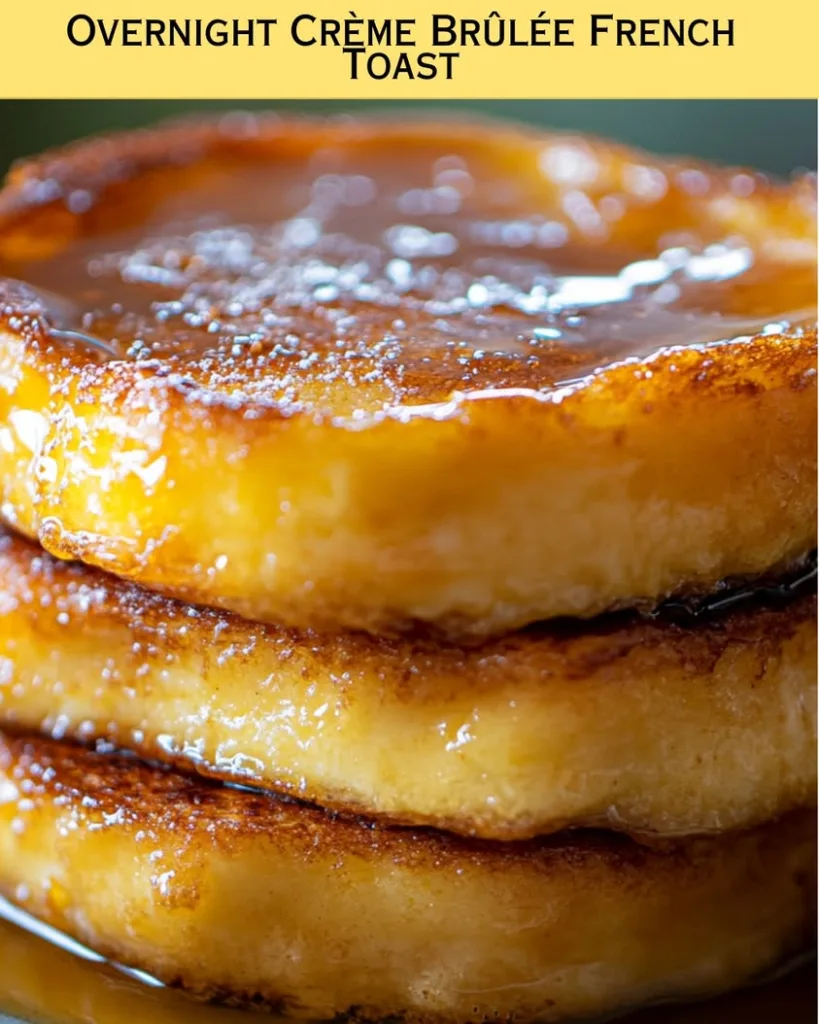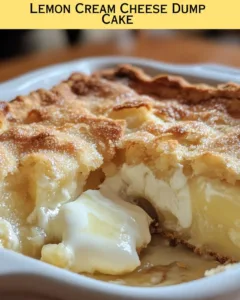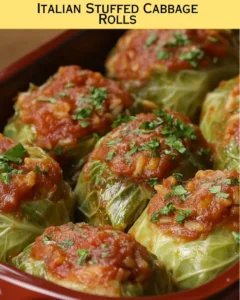Overnight Crème Brûlée French Toast: Indulge in Decadence
Indulge in the heavenly flavors of Overnight Crème Brûlée French Toast, a luxurious dish perfect for breakfast or brunch. This recipe takes the classic crème brûlée and beautifully transforms it into a rich and creamy French toast that promises to elevate any morning. The fusion of vanilla custard, caramelized sugar, and toasted bread delivers a symphony of flavors that dance on your taste buds, creating a culinary experience that you’ll want to savor over and over again.
What truly makes this dish extraordinary is its deep, custard-like texture reminiscent of freshly made crème brûlée. With every bite, you’ll delight in the crispy caramelized sugar topping that contrasts perfectly with the soft and fluffy bread soaked in a creamy vanilla mixture. The intoxicating aroma of vanilla wafting through the kitchen as it bakes sets the stage for a deliciously satisfying meal that’s as easy to prepare as it is delightful to eat.
Quick Recipe Highlights
- Flavor Profile: Rich, creamy vanilla with a touch of sweetness from caramelized sugar.
- Texture: Soft and custardy on the inside with a crispy caramelized topping.
- Aroma: Sweet vanilla notes mingling with hints of caramel that fill the air.
- Visual Appeal: Golden-brown topping with contrasting creamy bread underneath.
- Skill Level Needed: Suitable for those with basic baking skills and a willingness to learn.
- Special Equipment: A baking dish and preferably a kitchen torch for caramelizing sugar.
Recipe Overview
- Difficulty Level: This Overnight Crème Brûlée French Toast is considered intermediate due to the caramelization process, but clear instructions will guide you through it.
- Category: A breakfast or brunch stunner, perfect for lazy weekends or special occasions.
- Cuisine: A delightful fusion of French and American breakfast traditions, showcasing a beloved dessert in a new light.
- Cost: Generally an affordable dish to make, with ingredients that can fit into most budgets.
- Season: Delicious year-round, but particularly perfect during the cooler months when comfort food is craved.
- Occasion: Ideal for holiday breakfasts, gatherings, or any day when you want to treat yourself.
Why You’ll Love This Recipe
The taste and texture of Overnight Crème Brûlée French Toast are simply irresistible. The blend of the creamy vanilla custard infuses the bread, creating a melt-in-your-mouth experience with every bite. This dish not only satisfies your sweet tooth but also tantalizes your palate with a velvety texture that feels luxurious.
Convenience is another reason this recipe shines. Being an overnight dish means you can prepare it ahead of time, making mornings a breeze. Simply pop it in the oven while you get ready for your day, and you’ll have a beautiful breakfast waiting for you.
Nutritionally, with wholesome ingredients like eggs, milk, and bread, you can indulge without a nagging sense of guilt. The nutritional profile offers a fair balance for those looking to enjoy a treat while still being mindful of their diet.
When it comes to social and entertaining value, this delightful French toast serves beautifully and undeniably impresses guests. It’s perfect for gatherings or brunches, creating an atmosphere of indulgence and satisfaction among friends and family.
Lastly, the cost-effectiveness of this dish makes it accessible for everyone. With simple ingredients and minimal preparation, you can serve a gourmet-style breakfast at a fraction of the price you’d pay at a restaurant.
Historical Background and Cultural Significance
The origin of crème brûlée can be traced back to France, where it was beloved as a traditional dessert known for its unique crispy topping. Over the years, this dish has evolved, finding its way into breakfast menus as a creative way to enjoy the rich flavors of crème brûlée at the start of the day.
Culturally, crème brûlée holds a special place in French culinary tradition, symbolizing elegance and sophistication. Its presence in restaurants and homes reflects a yearning for indulgence and refined taste, making it a favorite dessert across various cuisines.
The evolution into a breakfast dish like this French toast speaks to the growing trend of innovative recipes that combine beloved ingredients in new and exciting ways. Chefs and home cooks alike have embraced the art of adaptation, bringing together the best elements of both sweet and savory.
Regional variations abound, with some recipes featuring fruit or different flavors like chocolate or hazelnut, showcasing how versatile this classic dessert can be. This adaptation is not just a meal; it’s a celebration of flavors and creativity.
Ingredient Deep Dive
- Bread: A cornerstone of this recipe, the type of bread used can significantly affect the dish. Challah or brioche provides a rich, soft texture, while sourdough can add a tangy contrast that enhances flavor. When choosing bread, opt for the freshest you can find, and ensure it’s slightly stale for optimal soaking. Store leftover bread correctly to prevent staling.
- Eggs: As a binding agent and source of richness, eggs play a crucial role. The egg yolks contribute creaminess, while the whites provide structure. When selecting eggs, choose high-quality, pasture-raised varieties for the best flavor and nutritional benefit. Eggs should be stored in the refrigerator and used before their expiration date for the best results.
- Heavy Cream: This ingredient adds the luxurious richness that defines crème brûlée. It’s important to use fresh, high-fat cream for the best texture. When buying, look for product labeling that indicates a high fat content. Heavy cream can be stored in the refrigerator and typically remains fresh for weeks, but always check for smell or spoilage before usage.
- Vanilla: The star flavor of this dish, pure vanilla extract enhances the sweetness and aroma of the custard. Using pure extract over imitation offers a more authentic taste. When selecting vanilla, opt for high-quality brands, and store it in a cool, dark place. You can substitute with vanilla bean for an even more intense flavor profile.
Common Mistakes to Avoid
- Not using stale bread: Fresh bread can become overly soggy, so it’s crucial to use slightly stale bread for optimal texture.
- Over-soaking the bread: Allowing the bread to soak for too long can cause it to fall apart. Aim for a soaking time that keeps it together while absorbing enough custard.
- Skipping step for burning sugar: Caramelizing sugar with a kitchen torch is essential. Skipping this step results in missing the signature crispy top.
- Using high heat for baking: High temperatures can cause the custard to curdle. Bake at a moderate temperature for the best results.
- Forgetting to cover the dish while baking: Covering the baking dish helps create a gentle steam effect, which retains moisture.
- Not letting it chill overnight: For the best flavor infusion, ensuring the dish rests overnight allows the bread to soak thoroughly in the custard.
- Neglecting to preheat the oven: Always preheat your oven; baking in an unheated oven can lead to uneven cooking.
- Inaccurate measuring: Baking is a science. Ensure all ingredients are measured accurately for a successful outcome.
Essential Techniques
- Soaking the Bread: It’s essential for the bread to absorb the custard mixture fully. Mastering this technique ensures each bite is creamy and flavorful. Avoid pitfalls by not soaking too long, which can lead to mushiness. Look for visual cues, such as the bread appearing saturated but still intact.
- Caramelizing Sugar: This technique adds the classic brûlée topping. Use a kitchen torch for a uniform melt. If you are not careful, you can scorch the sugar, so it’s important to move the torch in circular motions. Successful caramelization will yield a deep amber color and a crispy texture.
Pro Tips for Perfect Overnight Crème Brûlée French Toast
- Utilize quality ingredients, especially for the eggs and cream, to enhance the overall flavor of the dish.
- Substitute a variety of breads to experiment with different textures and flavors, such as banana bread or cinnamon raisin.
- For added depth, mix in fruit or nuts into the custard before soaking the bread.
- Serve warm and top with seasonal fruits for a refreshing contrast to the rich French toast.
- Adjust sugar levels according to your preference for caramelization; a thicker layer may yield a more substantial crunch.
- Consider using vanilla bean paste for an elevated flavor profile that enhances the visual appeal with specks of vanilla.
- Brûlée the sugar just before serving to maintain its texture and prevent it from getting soggy.
- Pair with a light dusting of powdered sugar for a beautiful finishing touch.
Variations and Adaptations
- For a fruity twist, try adding fresh berries or sliced bananas into the custard mixture before soaking the bread, introducing a burst of natural sweetness.
- Change the spices for seasonal variations; perhaps pumpkin spice for fall or a hint of citrus zest for summer freshness.
- Look for gluten-free bread options for a gluten-sensitive crowd; many gluten-free breads hold up well in custard dishes.
- Create a nutty version by adding sliced almonds or pecans into the bread mixture or as a garnish before serving.
- Experiment with flavored extracts such as almond or hazelnut for a unique taste experience; always start with a small amount and adjust to taste.
- For a savory take, consider reducing the sugar and using herbs or cheese instead, changing the dish into a breakfast casserole.
- Dress it up with a drizzle of maple syrup or a dollop of whipped cream for added indulgence.
- Garnish with edible flowers for a beautiful presentation, perfect for special occasions or gatherings.
Serving and Presentation Guide
- For plating this delightful French toast, begin with a large serving platter, stacking the pieces slightly for height and visual interest.
- Garnish with fresh fruits like strawberries, blueberries, or a sprig of mint to add a pop of color to the dish.
- Serve alongside a small pitcher of syrup or a dusting of powdered sugar for guests to customize their servings.
- Temperature is key; serve warm—consider warming the plates beforehand to enhance the experience.
- Portion control is important, especially if serving as a buffet; aim for smaller pieces allowing guests to enjoy multiple flavors.
- Accompany with classic breakfast beverages, such as freshly brewed coffee or mimosas, for the full brunch experience.
Wine and Beverage Pairing
- A sweet dessert wine such as Sauternes or a late-harvest Riesling pairs wonderfully with the rich flavors of French toast.
- For non-alcoholic options, consider a fresh-squeezed orange juice, offering a refreshing contrast to the creamy custard.
- For coffee lovers, a rich espresso or a latte complements the dish beautifully, enhancing the sweet and savory notes.
- Ensure drinks are served at their optimal temperature; chilled wines and steaming hot coffee create a delightful contrast.
- Pair with flavored teas, such as chai or vanilla-infused options, for a sophisticated touch to your meal.
Storage and Shelf Life
- Store any leftovers in an airtight container in the refrigerator for up to three days, maintaining its flavor and texture.
- For longer storage, consider freezing portions. Wrap them tightly in plastic wrap and aluminum foil to prevent freezer burn.
- Signs of spoilage include discoloration, off smells, and any signs of mold; discard if any of these are present.
- When reheating, do so gently in an oven or microwave, ensuring it heats evenly without drying out.
- Freezing is best done before the sugar caramelization step; this way, the crispy topping remains intact upon reheating.
Make Ahead Strategies
- To maximize flavors, prepare the custard mixture the night before; refrigerating helps the bread soak up the mixture thoroughly.
- Keep the baked French toast in the refrigerator and caramelize the sugar right before serving for a fresh texture.
- Consider assembling everything in the dish the night prior while preventing over-soaking by covering it and refrigerating.
- Wrap up any leftovers properly for easy reheating and serve again to enjoy for breakfast during the week.
- Add in fresh ingredients like whipped cream or fruit right before serving to maintain their freshness and flavor.
Scaling Instructions
- To halve the recipe, use a smaller baking dish and adjust the ingredient amounts accordingly for perfect results.
- When doubling or tripling, ensure to check your cooking time. Larger dishes may require more time to set properly.
- For scaling, keep ingredient ratios consistent to maintain flavor integrity and texture.
- Equipment adjustments may include using multiple pans if you’re expanding beyond the typical baking dish size.
- Be vigilant about storage; doubling the recipe may require additional airtight containers for proper storage of leftovers.
Nutritional Deep Dive
- Analyzing the macros reveals a balance of fats, carbohydrates, and protein from the cream, eggs, and bread, making for a substantial breakfast.
- Utilizing whole, fresh ingredients enhances micronutrient offerings, providing vitamins and minerals essential for a balanced diet.
- Consider dietary benefits such as high protein from eggs and calcium from dairy, vital for bone health.
- Monitor portion sizes, as enjoying a rich dish can impact daily caloric intake; moderation is key.
- Weight management can be supported by pairing this dish with a healthy side, like a fruit salad, to balance the meal.
Dietary Adaptations
- For a gluten-free option, substitute traditional bread with gluten-free varieties, ensuring they can absorb the custard well.
- Dairy-free adaptations can be achieved by using almond milk or coconut cream and a dairy-free bread selection.
- For vegan variations, replace eggs with flaxseed or chia eggs and use almond milk to create a creamy custard-like mixture.
- Low-carb enthusiasts can opt for sugar-free bread and adjust the recipe by using almond flour instead, keeping carbs minimal.
- A Keto-friendly version can be achieved with specific bread types designed for low-carb diets, easing the calorie count.
- For those following a paleo diet, using nut-based breads and natural sweeteners like honey can create a catered version.
- Low-FODMAP substitutions, such as gluten-free bread and lactose-free options, offer a suitable variation for sensitive systems.
- Other specific diets can be adapted creatively by utilizing the right ingredient swaps while keeping a focus on flavor.
Troubleshooting Guide
- Texture issues such as sogginess can occur if bread is too fresh; always use slightly stale bread for optimal texture.
- Flavor balance can be adjusted by varying sugar levels; if too sweet, blend in a bit of acidity like lemon zest to cut sweetness.
- Temperature problems may arise from uneven oven heat; utilize an oven thermometer to monitor reliable cooking temperatures.
- For equipment challenges, ensure your pan is not overcrowded; too little space between slices can lead to uneven baking.
- Ingredient substitutions can skew results; use similar ratios when swapping out for best outcomes to keep dish integrity.
- Timing concerns could lead to undercooking; always check for a custard-like consistency before removing from the oven.
Recipe Success Stories
- Community feedback often highlights how this dish has delighted both families and guests alike during holiday breakfasts.
- Variation successes include adaptations that readers have shared, leading to unique flavors and textures that surprise and please.
- Adaptation stories arise where home cooks have tailored this recipe to fit dietary restrictions while retaining a fantastic flavor.
- Reader suggestions often provide ingenious ideas, such as incorporating seasonal fruits or unique spices, breathing life into an already fabulous dish.
- Photography tips shared by others emphasize the importance of good lighting to truly capture the tempting appearance of the French toast.
Frequently Asked Questions
Can I prepare this dish the day before?
Yes! In fact, it’s best to prepare it the night before to allow the bread to soak thoroughly in the custard mixture, enhancing the flavors.
What kind of bread works best?
Rich bread like brioche or challah is ideal as they have a high egg and butter content, which creates a soft, custardy texture.
Can I use alternative sweeteners?
Absolutely! You can use honey or maple syrup as alternatives to granulated sugar for a natural sweetness.
How do I get the perfect caramelized top?
To achieve a crispy top, use a kitchen torch to melt the sugar evenly until it’s golden brown. Alternatively, place it under a broiler for a few seconds.
What do I do if my custard is too runny?
If the custard is runny after baking, it likely needs more baking time. Check for a set consistency before removing from the oven.
Can I freeze Overnight Crème Brûlée French Toast?
Yes, you can freeze the uncooked casserole; however, it’s best to do so before caramelizing the top sugar.
How long does this dish last in the refrigerator?
In the fridge, it can last about three days. Ensure to store it in an airtight container to maintain freshness.
Is there a gluten-free option for this recipe?
Yes! Use gluten-free bread varieties to accommodate gluten-sensitive individuals without sacrificing flavor.
Can I add fruits to enhance flavor?
Certainly! Adding fresh or dried fruits such as berries, bananas, or apples can provide extra flavor and texture to your French toast.
What beverage pairs well with this dish?
Sweet dessert wines or fresh juices work well, and for coffee lovers, a rich espresso is an excellent choice.
Additional Resources
- Check out our related recipes for more indulgent breakfast ideas, including savory and sweet options.
- Review our technique guides to master the art of bread puddings and custard desserts.
- Explore ingredient information for intricacies of substituting various dairy products in baking.
- Discover equipment recommendations to enhance your kitchen setup for baking enthusiasts.
- Don’t miss our seasonal variations to keep your baking fresh and aligned with what’s in season.
Join the Conversation
We would be thrilled to hear from you! Share your experiences with this recipe, and feel free to post your variations on social media using the hashtag #OvernightBruleeToast. Share your photography tips, or major flops, and engage with fellow culinary enthusiasts through our community board. Leave your recipe reviews that could inspire others to try this delightful dish and make it a go-to recipe for all breakfast lovers!
The Recipe
Overnight Crème Brûlée French Toast
Serves: 8
Prep Time: 15 mins
Cook Time: 30 mins
Total Time: 45 mins
Kitchen Equipment Needed
- Baking dish (9×13 inches)
- Mixing bowls
- Whisk
- Kitchen torch or broiler for caramelizing sugar
- Airtight container for soaking overnight
Ingredients
- 1 loaf of stale brioche or challah bread, cut into slices
- 6 large eggs
- 2 cups heavy cream
- 1 cup whole milk
- 1 cup granulated sugar, plus extra for caramelizing
- 2 teaspoon pure vanilla extract
- 1/4 teaspoon salt
Directions
- In a large mixing bowl, whisk together the eggs, heavy cream, milk, sugar, vanilla extract, and salt until well combined.
- Place the bread slices into a greased baking dish, overlapping them slightly.
- Pour the custard mixture over the bread, ensuring each slice is soaked well. Cover and refrigerate overnight.
- The next day, preheat the oven to 350°F (175°C).
- Bake for 30 minutes or until the custard is set and the top is lightly golden.
- Remove from the oven and allow to cool slightly. Use a kitchen torch to caramelize the sugar on top until bubbly and golden. Serve warm.
Recipe Notes
- Feel free to add spices such as cinnamon or nutmeg for extra flavor.
- This dish can be assembled and left to sit overnight, ensuring a deliciously rich flavor.
- Store any leftovers in an airtight container for up to three days.










